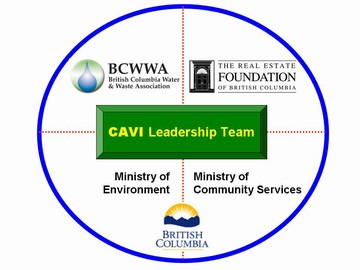CAVI explained

Roundtable of Vancouver Island partnerships provides leadership in water sustainability
CAVI is the acronym for Convening for Action on Vancouver Island. CAVI is a regional demonstration program that is being implemented under the umbrella of the Water Sustainability Action Plan for British Columbia. CAVI was formally launched in September 2006 by means of a consultation workshop held as an adjunct to the Water in the City Conference.
At the time of launching, the CAVI Leadership Team announced that: “By 2010, the CAVI vision is that Vancouver Island will be well on its way to achieving water sustainability.”
CAVI is an inclusive partnership. CAVI is reaching out to groups that share a vision for Vancouver Island, with the goal of creating a roundtable of partnerships. For more information about the 2007 genesis, please click on this link to CAVI Announcement.
The article below provides historical context. The article was written in June 2007 in response to queries that resulted from the success of the Creating Our Future Consultation Workshop.
Who is CAVI?
CAVI is an initiative that is currently being implemented under the aegis of the Partnership for Water Sustainability in British Columbia, a not-for-profit society incorporated in November 2010.
The original CAVI Partnership comprised the British Columbia Water & Waste Association, the Real Estate Foundation of British Columbia, the provincial Ministries of Environment and Community Services, and the Green Infrastructure Partnership.
During the period 2007 through 2011, CAVI was co-funded by the Province and the Real Estate Foundation of British Columbia. Until 2010, the Water Sustainability Committee of the BCWWA was the managing partner and provided program delivery.
An initiative of the Partnership for Water Sustainability
The 2010 Land Awards Gala, an event hosted by the Real Estate Foundation of British Columbia on November 18, provided a platform for announcing incorporation of the Partnership for Water Sustainability in British Columbia as an autonomous society.
 “The Partnership had its genesis in the Water Sustainability Committee, known to many by the acronym WSC, a technical committee of the BC Water & Waste Association. From 2003 through 2010, the WSC was the hub for a partnership network operating in the local government setting. Going forward, the Partnership is now that hub,” stated Tim Pringle, Partnership President.
“The Partnership had its genesis in the Water Sustainability Committee, known to many by the acronym WSC, a technical committee of the BC Water & Waste Association. From 2003 through 2010, the WSC was the hub for a partnership network operating in the local government setting. Going forward, the Partnership is now that hub,” stated Tim Pringle, Partnership President.
The Partnership provides a legal entity for further evolution and delivery of program elements developed under the umbrella of the Water Sustainability Action Plan for British Columbia, released in February 2004.
To Learn More:
What does CAVI do?
The purpose of CAVI is to provide research and education for practitioners (primarily local government administrators, engineers, planners and elected officials) so that they can plan for sustainable water resources in the context of burgeoning settlement activity.
What does CAVI want to do?
Between 2007 and 2010, the CAVI Leadership Team stated that the CAVI mission is to:
- Integrate with other groups
- Bring together local government and the development community
- Encourage introduction of a ‘design with nature’ way-of-thinking in local government decision processes
- Celebrate examples of green infrastructure that achieve ‘design with nature’ outcomes
- Evolve a framework for water-centric planning that is keyed to accepting and managing risk, learning by doing, and rewarding innovation
For more information about CAVI, go to Vancouver Island Water comnunity-of-interest and/or contact partnership@watersustainabilitybc.ca
What is the role or involvement of local government with CAVI?
To learn from the experience of other municipalities in implementing green infrastructure, the CAVI Leadership Team announced in June 2007 that local government elected officials and/or staff could:
- 2007 Showcasing Innovation on Vancouver Island Series – Attend the three seminar/field tour events that will be held in Nanaimo (September 14), Cowichan Valley (September 28), and Courtenay (October 12). These events are designed to promote networking and sharing of on-the-ground experience.
- Water Balance Model Training Workshop – Attend a hands-on training session that will likely be held in a computer lab at the Cowichan Valley campus of Malaspina College later in 2007. The Water Balance Model is a web-based tool for ‘green design’. The main focus is on source controls for reduction of rainwater runoff volume.
- 2007 Green Infrastructure Forum – Attend a ‘learning event’ for elected officials that CAVI is planning to organize in collaboration with AVICC later this year. This event would build on the Creating Our Future Workshop that was held as a shoulder event to the Gaining Ground Summit Conference in June 2007.
These initiatives in 2007 created the early momentum that branded CAVI and provided the foundation for continuing success in the years following.
How do I learn more about CAVI?
For earlier stories that provide background information leading up to the Creating Our Future Workshop in June 2007, click here. For current information, click on Vancouver Island Water .
According to John Finnie, CAVI Chair from 2006 through 2011: “If we are to control our destiny and create our future, then we need to challenge our fellow Vancouver Islanders to visualize what they want  Vancouver Island to look like in 50 years. We have identified two desired outcomes in Convening for Action. First, we wish to influence Vancouver Island local governments to adopt Design with Nature as the preferred process of approving land development applications. Secondly, we intend to facilitate the move from awareness to action in changing the way that land is developed and water is used on Vancouver Island.”
Vancouver Island to look like in 50 years. We have identified two desired outcomes in Convening for Action. First, we wish to influence Vancouver Island local governments to adopt Design with Nature as the preferred process of approving land development applications. Secondly, we intend to facilitate the move from awareness to action in changing the way that land is developed and water is used on Vancouver Island.”
Posted June 2007
Revised July 2012

